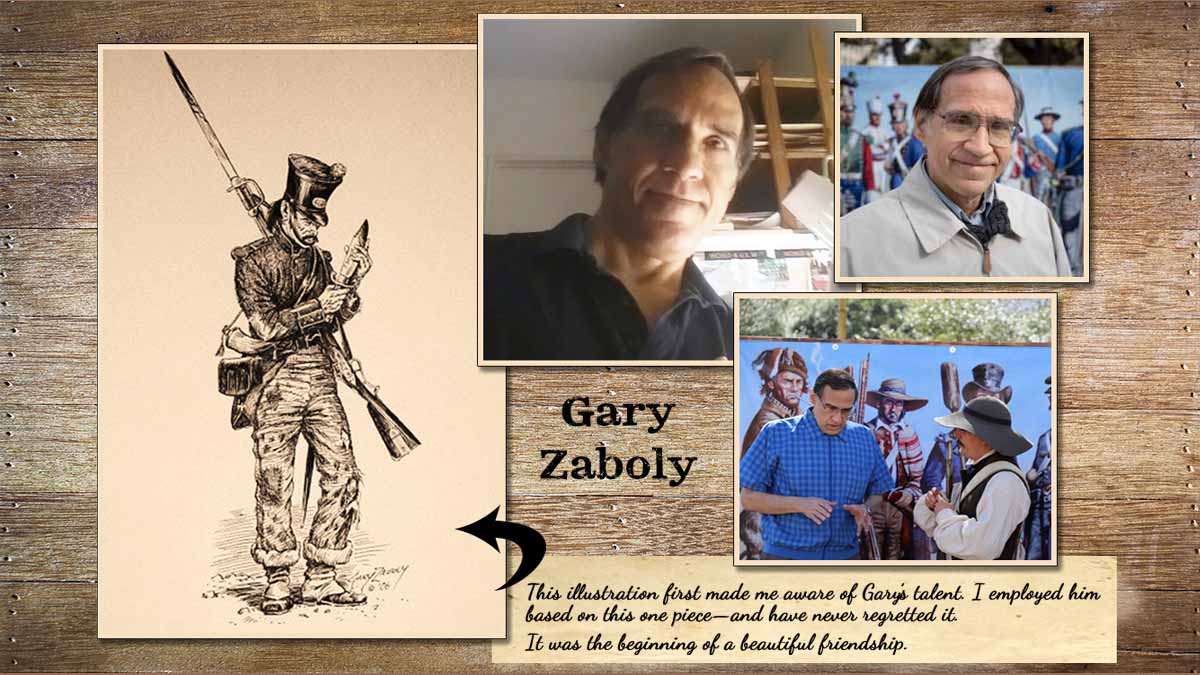
If you’ve read, Texian Iliad, Texian Macabre, or Lust for Glory, you will be aware how much the fabulous illustrations of my friend, collaborator, and “partner in crime,” Gary Zaboly, contributed to those books. Ours is an unlikely friendship; Gary is a born-and-bred son of New York City and I am a Texan to my toenails. Yet, as Baby Boomers, we grew up watching many of the same movies, reading many of the same books, and sharing many of the same cultural experiences. Consequently, despite our vastly different backgrounds, we are simpatico.
Gary—or rather, his work—first came to my attention around 1992. The University of Texas Press was publishing Texian Iliad, but I knew it needed illustrations. (By the way, my editor tried to talk me out of the illustrations. She told me that “the book didn’t really need them.” I knew better and stuck to my guns. A life lesson: “Sometimes authors need to reject the advice of their editors.) But I needed an illustrator—and couldn’t find one.
Then one day an issue of The Alamo Journal arrived in my mailbox. On the cover was a haunting image: a disheveled Mexican cazador examining a souvenir of the Alamo battle: Jim Bowie’s enormous blade. The drawing grew on me; the more I studied it, the more I liked it. I realized then that I had found my man.
I called up my friend, Bill Chemerka, then editor of The Alamo Journal, and asked for Gary’s phone number. With considerable trepidation, I gave him a ring. I had worried for naught; Gary couldn’t have been nicer. Indeed, once we began talking, it seemed as if we had known each other all our lives. Gary agreed to illustrate Iliad and we set off on our first grand adventure.
I explained to Gary that what I required were not historical suppositions, but rather historical reconstructions. He had to base every weapon, every article of clothing, and every accoutrement on a museum specimen or period image. I supplied the references. Gary then drew rough pencil sketches and sent them to me for my inspection. Once I had approved the pencil sketches, he’d ink the final illustrations. We vowed to keep each other honest.
I commissioned ten character studies—one for each chapter—plus a cover illustration, which also served as the frontispiece. The “Tejano Volunteer” was the first to arrive. It blew me away and still remains one of my favorites.
The “Cazador, Toluca Battalion” and the “Trooper, Mexican Light Cavalry” presented special challenges. I could not convey in words the image I had inside my head. I was teaching at The Victoria College at the time and had the campus photographer to shoot me in the poses I had imagined. I sent the photos to Gary and they worked like a charm. Only later did I learn that the campus photographer filed ever photo he ever took. Someday a future researcher examining this photographic archive will wonder why there are images of a crazy bearded guy in all sorts of contorted positions. Ahh, the things we do for art!
When Gary was working on the “Mississippi Volunteer,” we ran into a snag. I had not provided a reference for an 1830’s earthenware jug. Gary called me on it; I had to admit that I had no idea what 1830’s jugs looked like. Gary reviewed his sources. The nineteenth-century American artist George Caleb Bingham painted a lively scene titled, “Jolly Flatboatmen in Port.” Sure enough, sitting on the deck is a period earthenware jug—the very jug our young Mississippi Volunteer hoists on page 50.
In Texian Macabre, a Zaboly illustration appears titled, “Carnage.” It presents Goliad escapee David James Jones and Brigadier General Thomas Jefferson Rusk viewing the decomposed remains of Goliad Massacre victims. I explained to Gary that I wanted him to capture the vibe of the artwork that appeared in the 1960’s Creepy magazine. Since Gary and I are about the same age, he immediately understood the reference. It’s nice to work with a fellow “Boomer” who is on the same wave length.
I once had a fellow tell me how much he had enjoyed reading Texian Iliad.
“You know what I like most about that book?” he asked.
“Sure,” I replied, “the illustrations.”
That brought him up short. He realized that he had just been going on about parts of the book that I had nothing to do with. He began to apologize, but I stopped him.
“Nah, don’t worry about it,” I told him. “They’re my favorite parts of the book too.”
My personal and working relationship with Gary has brought joy to my life. Neither one of us is a spring chicken, but I believe we still have enough juice to complete a few more projects. At least, I hope so.
Watch this space!
